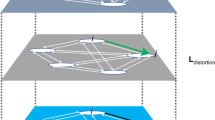Abstract
By revealing who has really influenced the course of science the Science Citation Index seems to be a valuable sociometric tool for historians and sociologists.
This is a preview of subscription content, access via your institution
Access options
Subscribe to this journal
Receive 51 print issues and online access
$199.00 per year
only $3.90 per issue
Buy this article
- Purchase on Springer Link
- Instant access to full article PDF
Prices may be subject to local taxes which are calculated during checkout
Similar content being viewed by others
References
Watson, J. D., Double Helix (Athaneum, New York City, 1968).
Price, D. J. de Solla, Bulletin of Atomic Scientists, 21, No. 8, 2 (1965).
Parker, E. B., Paisley, W. J., and Garrett, R., Report on Stanford Univ. Project Science Information Exchange among Communication Researchers, Standord Univ. Institute for Communication Research, Stanford, California, 1967).
Martyn, J., ASLIB Proc. 17 (6), 184 (1965).
Malin, M. V., Library Trends, 16, No. 3, 374 (1968).
Price, D. J. de Solla, Science, 149, 510 (1965).
Garfield, E., “World Brain or Memex? Mechanical and Intellectual Requirements for Universal Bibliographic Control,” reprinted from The Foundations of Access to Knowledge, 169 (Syracuse University Press, NY, 1968).
Spencer, C. C., Amer. Documentation, 18 (2), 87 (1967).
Martyn, J., and Gilchrist, A., ASLIB Occasional Pub. No. 1 (1968).
Garfield, E., Science, 122, 108 (1955).
Garfield, E., Sher, I. H., and Torpie, R. J., The Use of Citation Data in Writing the History of Science (Institute for Scientific Information, Philadelphia, 1964).
Zirkle, C., J. Hered., 55, No. 2, 65 (1964).
Garfield, E., and Sher, I. H., Diagonal Display—A New Technique for Graphic Representation of Complex Topological Networks (Institute for Scientific Information, Philadelphia, 1967).
Giuliano, V. E., IEEE Trans. on Military Electronics, MIL-7 (2 and 3), 221 (1963).
Cole, S., and Cole, J. R., Amer. Sociol. Rev., 32, 377 (1967).
Bayer, A. E., and Folger, J., Sociol. of Education, 39, No. 4, 381 (1966).
Martino, J. P., in Readings in Managing Organized Technology (edit. by Cetron, M. J., and Goldhar, J. D.) (Gordon and Breach, in the press); Martino, J. P., AFOSR Research AD 659 366 (edit. by Taylor, D.), 226 (US Air Force Office of Aerospace Research, Arlington, 1967).
Garfield, E., and Malin, M. V., 135th Meeting, Amer. Assoc. Adv. Sci., Dallas (1968).
Nature, 224, 529 (1969).
Garfield, E., J. Patent Office Soc., 39, No. 8, 583 (1957).
Author information
Authors and Affiliations
Rights and permissions
About this article
Cite this article
GARFIELD, E. Citation Indexing for Studying Science. Nature 227, 669–671 (1970). https://doi.org/10.1038/227669a0
Issue Date:
DOI: https://doi.org/10.1038/227669a0
This article is cited by
-
Ranking journals by voting with feet: a new method for journal evaluation
Scientometrics (2024)
-
Research progress and hot spot analysis related to oxidative stress and osteoarthritis: a bibliometric analysis
BMC Musculoskeletal Disorders (2023)
-
Evaluating scientists by citation and disruption of their representative works
Scientometrics (2023)
-
Examining Knowledge Diffusion in the Circular Economy Domain: a Main Path Analysis
Circular Economy and Sustainability (2023)
-
A two-fold evaluation in science: the case of Nobel Prize
Scientometrics (2023)
Comments
By submitting a comment you agree to abide by our Terms and Community Guidelines. If you find something abusive or that does not comply with our terms or guidelines please flag it as inappropriate.



